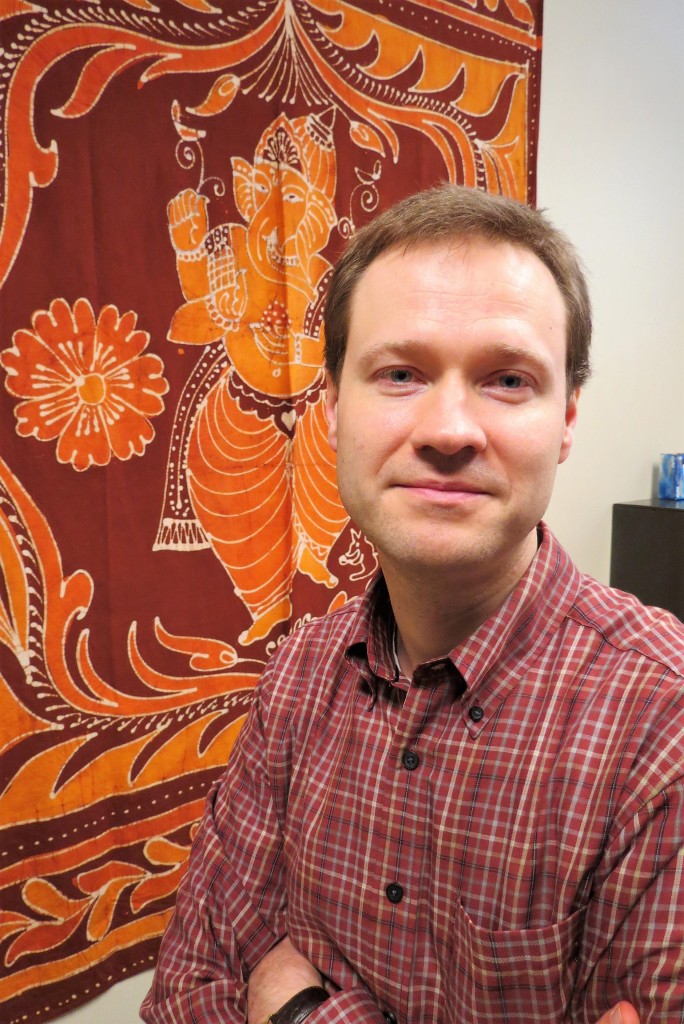Written by guest blogger, Michael Nichols.
Judging by the looks on their faces, the students were having trouble processing what they were seeing. On the screen, a rotund, green beast with horns – not unlike a cross between “Casper the ghost” and Disney’s “Shrek” – floated before a meditating figure. The clip was from an animated version of the Buddha’s life intended for children, put together by a group called “Geethanjali Kids.”
The segment I showed focused on the Buddha’s temptation by Māra, lord of death and desire. Previously in the course, which covered figures of evil across religious traditions, we had considered ancient Buddhist textual accounts and artistic depictions of Māra. This example from a more recent popular culture medium seemed to leave the students uncertain about how to proceed. Some snickered, while others furrowed their brows.
 Michael Nichols, author of ” Returning the Demon’s Gaze: Analyzing the Buddhist Figure of Māra in Popular Culture” which appears in Vol. 29, Issue 1 of the Journal of Religion and Popular Culture.
Michael Nichols, author of ” Returning the Demon’s Gaze: Analyzing the Buddhist Figure of Māra in Popular Culture” which appears in Vol. 29, Issue 1 of the Journal of Religion and Popular Culture.In my recently published article “Returning the Demon’s Gaze,” I partly argued that analysis of Māra’s popular culture representations can provide insights on the historical forces continuing to shape representations of the figure. I asked the students to approach the animated clips from that vantage: what does the depiction tell us about possible cultural influences on the figure of Māra that would not have been present in the ancient texts? With that in mind, the comparisons to Casper and Shrek took on a new light, suggesting to several that the dynamics of globalized popular culture (especially a kind of “Disney hegemony”) had exerted their potency on Māra.
Framed this way, the study of religious symbols in popular culture is about far more than finding entertaining ways to engage students or relate to the objects of our research. At a conference once, a colleague actually inquired whether my interest in popular culture was, at best, “fluff” or, at worst, a degradation of the study of religion. Working off this scholar’s underlying assumption of a division between high and low culture, with religious beliefs obviously a part of the former, I responded that I saw such studies not as a degradation of religion, but an elevation of popular culture. In truth, the overlaps and ambiguities of both the concepts of “religion” and “popular culture” permit of no such easy dichotomies. Efforts such as my recent article on Māra will hopefully contribute to understanding these interconnections.
Despite the increasing prominence of the study of religion and popular culture, we still face skepticism, as voiced by my colleague and initially by my students. On the latter score, however, the tone certainly changed. By semester’s close, after studying a variety of religious symbols of evil across the world, we ended with Alan Moore’s The Killing Joke, a graphic novel dealing with Batman and the Joker. With prior experience dealing with animated Māra, the class seemed far more nimble in highlighting the potential themes and symbolic comparisons. Ultimately I was heartened to see that they seemed on their way to becoming insightful critics of the intersections of religion and popular culture.
Michael Nichols’ article, “Returning the Demon’s Gaze: Analyzing the Buddhist Figure of Māra in Popular Culture” appears in Vol. 29, Issue 1 of the Journal of Religion and Popular Culture, available to read here: http://bit.ly/jrpc291d
Comments on this entry are closed.